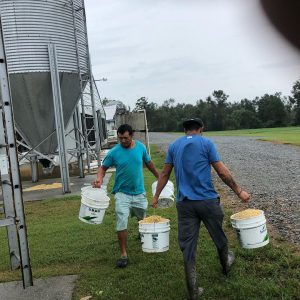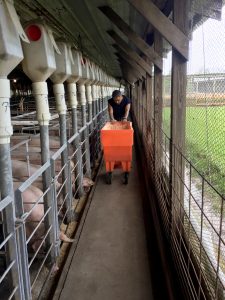Five days after Hurricane Florence struck North Carolina, most of our 2,100 hog farms are returning to normal operations. For a small portion of farms, logistical challenges amid record levels of flooding continue as hog farmers and partner production companies are taking extraordinary steps to ensure animal care. In many cases, this means farmers have remained at the barns for days without access to the outside world because they are remaining with their animals. In others, farmers are accessing the barns by boat and, in a few cases, farmers and employees have shuttled to barns by helicopter to reach the animals. The size of the area impacted by the hurricane that involves our operations is across 14 counties, the total size of which is larger than the states of Massachusetts and Rhode Island combined.
Feed
Most farms pre-stocked with feed ahead of the storm, but power outages and other failures have knocked some automatic feed systems off-line. This is a temporary setback and workers are delivering feed by the bucket or cartload. In some cases, meals are being rationed to stretch the feed out. In some instances, feed bins were knocked over, which makes the feed unusable, so efforts are being made to deliver feed by whatever means necessary (tractor, helicopter, trucks, boats, etc.).
Power
Each farm has backup generators that are tested weekly, but in some cases, they were overwhelmed by the storm. Generators are used to provide water, for automatic feed systems, and to provide automatic ventilation, which is crucial to maintaining comfortable temperatures. Companies are working overtime to restore power. We are grateful for the hard work being provided by local utility companies and many others from across the nation who are assisting to restore power as quickly as possible to our rural areas.
Lagoons
While it is clear that farmers properly managed lagoon levels in advance of the storm, a small percentage of lagoons have been impacted by the record-setting rainfalls. Farmers are in regular communication with the state Department of Environmental Quality and plans of action are being implemented in coordination with the regulatory agency. In some cases, lagoon levels are being lowered by transferring liquids off the farm in tanker trucks or by piping to other lagoons with ample capacity.
We are currently aware of the following impacts to lagoons:
- At the time of this posting, State DEQ is reporting five sites with possible structural damages, three of which we believe to be breached. Two of the lagoons lost liquids and the solids remain. We do not have information about the third.
- Twenty-one lagoons were inundated by flood waters.
- Seventeen lagoons were at capacity due to rainfall and appear to have overtopped. Others are at capacity and efforts are being taken to respond within state regulations and guidance.
Most of the 2,100 farms with more than 3,300 anaerobic treatment lagoons in the state did not see these significant impacts from the storm. However, at this time, we still expect there could be additional impacts to be reported as conditions warrant.
While we are dismayed by the release of some liquids from some lagoons, we also understand that what has been released from the farms is the result of a once-in-a-lifetime storm and that the contents are highly diluted with rainwater. We believe that the result of this storm will be similar to what has occurred in previous events, including what the state Division of Water Resources found after Hurricane Matthew: “…the amount of water discharged into the river basins resulted in a diluting effect, which primarily resulted in lower than normal concentrations of various pollutants.” Link to the complete report.
The National Weather Service announced that it estimates more than 8 trillion gallons of water fell across North Carolina over a five-day period.





